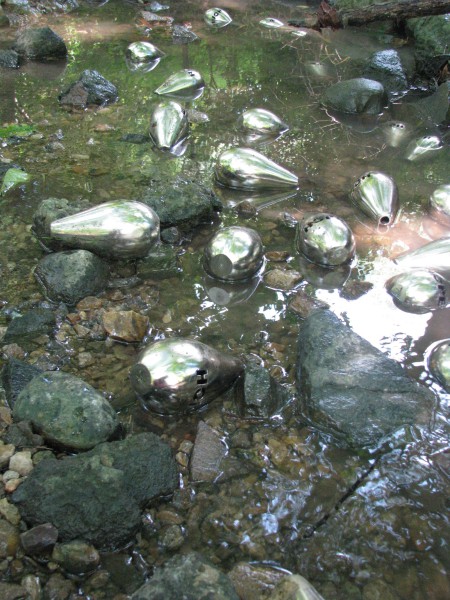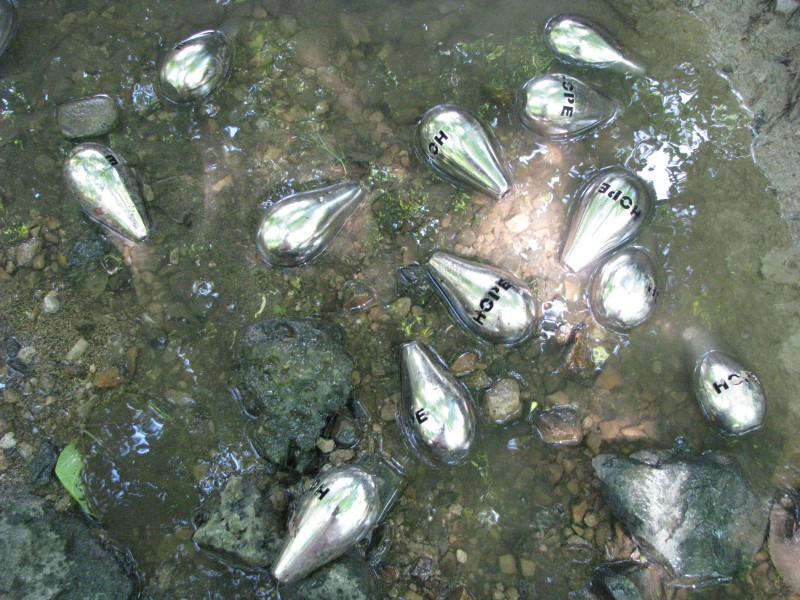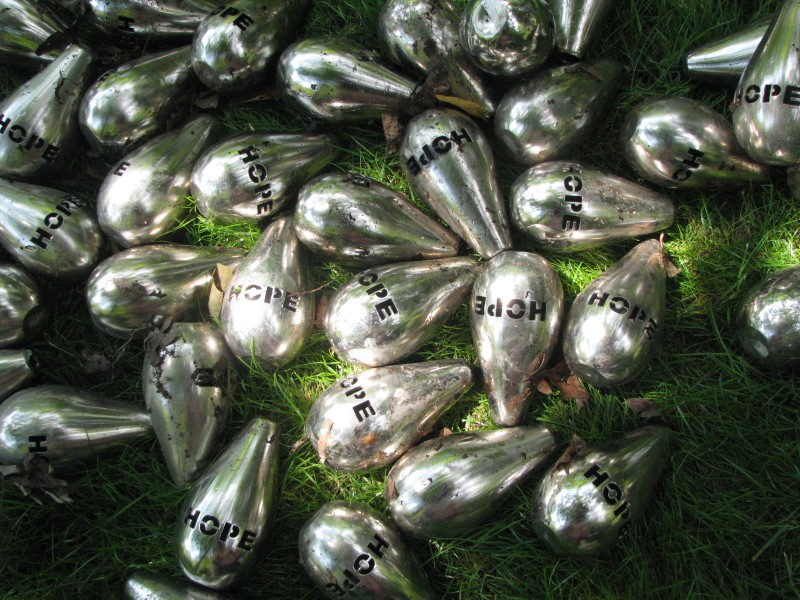| Lee Tracy |
100 TEARS is a long-term, 3 part project about crying and human tears. Started in 2001, it is in progress. 100 Tears explores memory and sentimentalities, and the correlation between human vulnerability, our interconnectedness, and the possibility of transcendence. The mediums of glass, a hard metal and a reflective surface are used to make a series of tears that address the different types of emotive states; fragile, heavy and illuminant. Each series of tears is created in two sets, one set is transformed in meaning and appearance by exposure to the elements, the other is kept pristine. The transparent quality of glass, used in Part 1, references the fragile interior experience, the vulnerable. The use of bronze in Part 2 references the gravity of hardened realities. The use of silver in Part 3 references reflection and change, the potential for transformation. Read the full installation text in the archive. 100 Tears from Lee Tracy on Vimeo. Accompanying the installation is a video projection with three parts streamlined as a loop. The visual settings preserve the textual content. Starting with translucent pages seemingly blown by the wind in Part 1, to the movement of the ocean tide in Part 2, and In Part 3, a complete daily cycle of the sun.  100 TEARS, PART 1 One hundred handblown glass tears sit on the floor of my studio (an old boiler room.)  Each tear is 7" to 8" in size and contains a parchment strip on which a sentence is handwritten.  Each statement references an event, an act, a memory which moved me to cry while living in the culmination of the twentieth century.  An accompanying video, viewed as a projection, shows each tear's statement handwritten on a parchment page.  Each page turning slowly as if pushed by a slow breeze, while one statement grows faint beneath another to simulate the sensation of memory.  In the fall of 2002, in the desert at Valley of the Gods near the four corners where Arizona, Colorado, New Mexico and Utah meet, the glass tears underwent a transformation of content.  Each handwritten strip was touched by dirt and water.  The once prestine personal declarations, the condition of pain, begins to be aged and worn.  The tears were contained in a stone circle next to a stone shaped star that was already there.  The plateau is near the Navajo mountain Nahasdzaan, "head of the earth," a large sacred dome.  The location sits on the Nasja Mesa which is home to the spirit of the owl.  We spent the night sleeping beside the installation. In the fall of 2003 the glass tears were buried (for 5 years) in the New Mexico desert. Again, I use my hands and interact with earth. A temporary grave is dug for the tears.  The sun sets on the tears that will be covered and retrieved 5 years later.  Stones are placed on top of the resting place, a location on the edge of the Cibola National Forest and not far from the Very Large Array (radio astoronomy observatory) on the Plains of San Agustin. In 2008 the tears were collected after years of rain and flooding. We had to search for the tears and some where never found. The final installation includes pristine glass tears and those unearthern, including a few that were broken.  100 TEARS, PART 2 100 bronze tears have 100 disturbing traits of humanity carved into the heavy metal.  The first setting is a city scape created with a sense of permanence.  The city could be any city, illustrating the effects of the concentration of humans.  The sun sets, causing the tears and the words to become prominent.  In the fall of 2006 the tears went to the east coast to rest in the salt of the Atlantic Ocean.  The location is Buzzard's Bay, territory originally home to the Wampanoag and settled by Europeans in 1621.  When the tears were out in the ocean air, the oxidation process began quickly.  A lobster trap was prepared to hold the tears and was chained tightly so as not to break apart in the tidel waters.  It was easy to imagine that the bronze tears would change if left alone for some time. (6 years) In the fall of 2011 the bronze tears were collected. Here, they rest on a stone wall surrounding a seaside garden.  The tears are a nice patina and the words are less sharp, in most cases filled with ocean flora.  100 TEARS, PART 3 100 tears of shiny silver (pewter covered with chrome) have the word "HOPE" cut into them.  The Hope tears' first location is a place high and cold. Denali wilderness, with the highest point in the US, was selected.  Denali (also known as Mt. Mckinley) is the highest mountain in North America, just over 20,000 ft above sea level. We landed on a glacier that was 1 mile wide and 3600 feet deep moving 3" to 6" a day, depending on the time of year. The cliffs rose up 5000 ft above us.  Althought the temperature was mild we were close to the sun and the tears quickly absorbed its heat, sliding about and toppling over.  I didn't see one spec of trash and I breathed the finest air I that I could remember. Part 3 is in progress and will be completed in 2020. The tears of hope are currently exposed. They are not buried or submerged. The Hope tears are in the open air in a location of meaning. Hope from Lee Tracy on Vimeo. A trio of books, Box of Tears, in an unfolding custom box, references the 100 Tears project. Learn more about my handmade books and how my projects have influenced a work in progress called My Gamma Waves.  Today my tears of hope are with me at the house on the forest preserve.  They are traveling through the seasons of many years.From frozen icy cold to the heat of summer, from rains and flooding to spring and fall.  Soon they will be ready. |
| Lee Tracy |